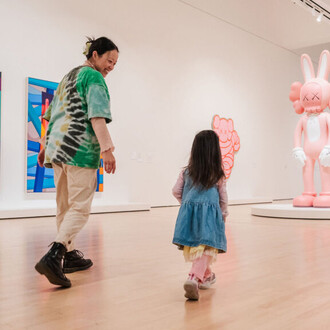Crown Point Press announces King Phillip Came Over From Germany Stoned, an exhibition of four new color etchings and a sculpture by Gay Outlaw, accompanied by a group of prints she has selected from Crown Point’s inventory. Outlaw is a San Francisco-based sculptor, photographer, and printmaker who approaches a broad range of media with a playful and inventive outlook. Her ideas range from food, animals, family relationships and everyday objects, to ways of seeing. The title she chose for the show, King Phillip Came Over From Germany Stoned, is a mnemonic device for memorizing the taxonomic order: Kingdom, Phylum, Class, Order, Family, Genus, and Species. Biological classification represents an understanding of evolutionary relationships, not unlike the harmonious connections among the prints in the exhibition. The thoughtfully curated "family" of prints includes work by Chris Burden, John Cage, Francesco Clemente, Elaine de Kooning, Marcel Dzama, Joan Jonas, Alex Katz, Sol LeWitt, Tom Marioni, Susan Middleton, Laura Owens, Markus Raetz, Ed Ruscha, Wayne Thiebaud, and Richard Tuttle.
Familial relations are important to Outlaw’s creative process, both in motivational and material aspects. She sometimes recalls memories of her childhood and her own children when thinking about the process of learning something new, like printmaking. Outlaw created a print at Crown Point, First Painting/First Print (2001), as an homage to her grandfather who taught her how to paint. Similarly, her new print ted4phoebe (2019) is a small etching inspired by her daughter's childhood drawings. It depicts five cats, each a different breed, with individual circles drawn around them. The encircled cats are linked together by lines, indicating an enigmatic connection.
As a photographer, Outlaw is an observant chronicler of her surroundings and uses images as a springboard for her art. She generally focuses on a singular aspect within an image, and investigates that aspect’s meaning and material. A new print, 3x3 is a bold orange etching with familiar shapes animating the space. Outlaw chose the nine shapes in 3x3 from her own photographs because of their energetic forms. She selected one of her sculptures, Wedge (2014), for inclusion in the exhibition to add a sense of materiality and to reference the forms seen in her prints. The prints and the sculpture relate to one another through what Outlaw calls "formal free association."
When curating the exhibition, Outlaw was drawn to Type, the portfolio by Richard Tuttle, because of Tuttle’s unconventional approach to printmaking. Each color etching in the series of 26, Tuttle has said, corresponds to a letter of the alphabet. Nevertheless, there are no recognizable letters, only geometric shapes and painterly splashes. By re-envisioning the alphabet, Tuttle examined the complexity of language in an abstract way. He physically incorporated tarlatan cloth, a material used in the Crown Point studio, into his prints by using the chine collé method. The added sculptural dimension that the tarlatan creates was discovered in a search for a "new plane of consciousness," Tuttle explained. Outlaw’s print Juss appears sculptural and its texture reflects the tarlatan’s surface seen in Tuttle’s Type. Instead of adding material directly to the print, Outlaw pressed tulle into soft ground plates to create texture and layers of color. The four plates of color that make up the final image mimic the four-color printing process used in color photogravure.
Gay Outlaw was born in Mobile, Alabama. Her work has been shown nationally and internationally in exhibitions at Le Consortium, Dijon, France (2018); the Aspen Art Museum, Aspen, CO (2018); the Sculpture Center in New York (2001); the University Art Museum, Cal State Long Beach (2001); Mills College, Oakland, CA (2005); the Jordan Schnitzer Museum of Art, University of Oregon, Eugene, OR (2016); and the San Francisco Museum of Modern Art, where she received the SECA Award (1999). Her artworks are in the collections of the Fine Arts Museums of San Francisco, the SFMOMA and the Berkeley Art Museum. She is represented by Anglim Gilbert Gallery in San Francisco.
















